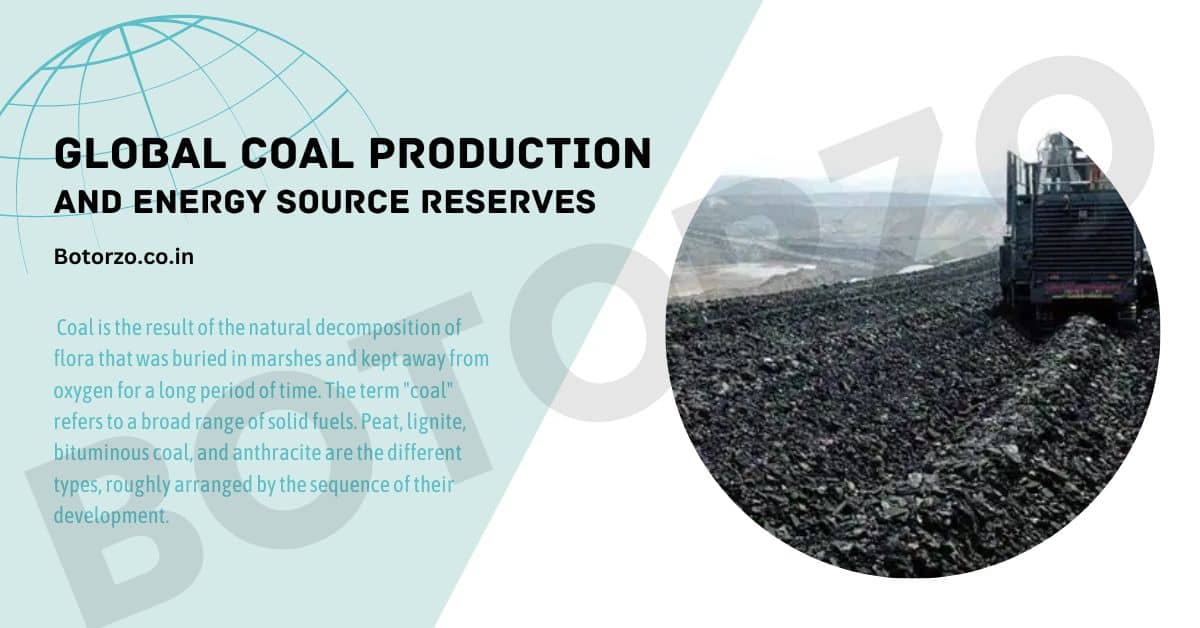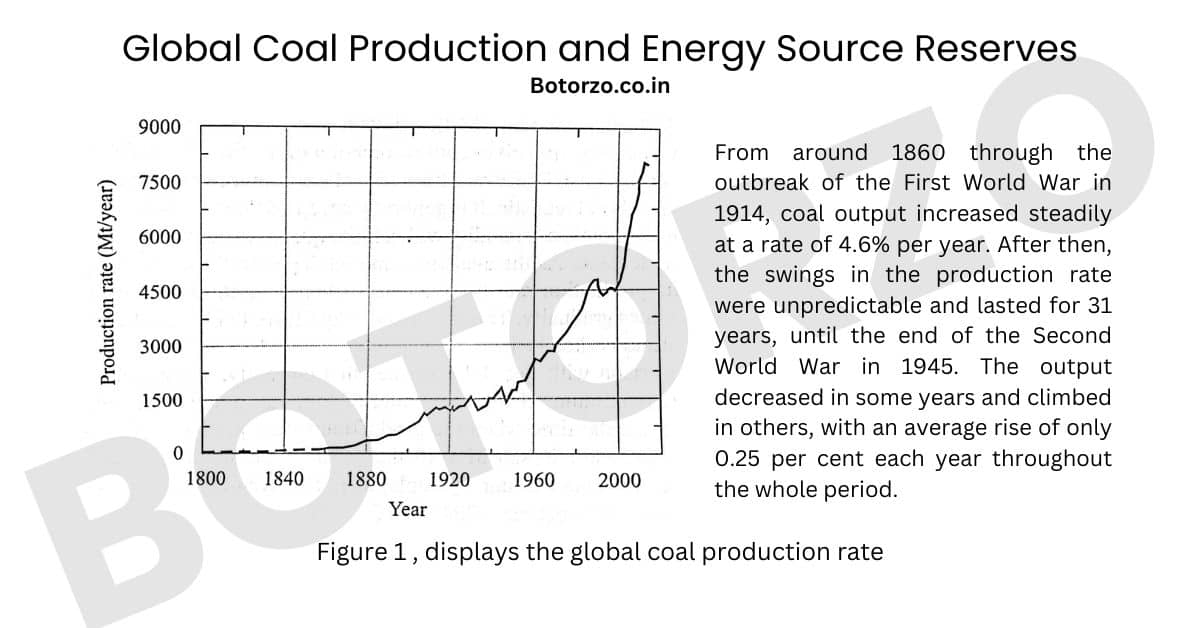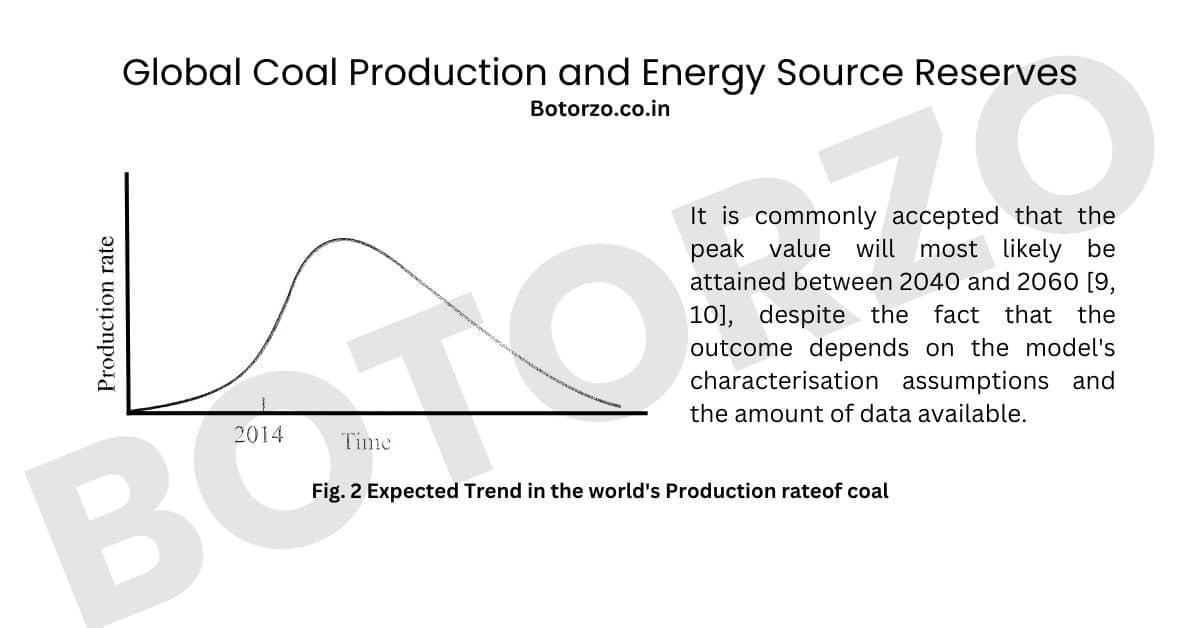
Coal: Coal is the result of the natural decomposition of flora that was buried in marshes and kept away from oxygen for a long period of time. The term “coal” refers to a broad range of solid fuels. Peat, lignite, bituminous coal, and anthracite are the different types, roughly arranged by the sequence of their development.
Abbreviation: Mt- Mega Tones.

Figure 1, [1–3] displays the global coal production rate since considerable amounts of coal have been used.
- From around 1860 through the outbreak of the First World War in 1914, coal output increased steadily at a rate of 4.6% per year.
- After then, the swings in the production rate were unpredictable and lasted for 31 years, until the end of the Second World War in 1945.
- The output decreased in some years and climbed in others, with an average rise of only 0.25 per cent each year throughout the whole period.
The annual output rate increased (more or less continually) between 1945 and 1990 at a rate ranging from 2% to 4% each year. Production in 1980 was 3792 Mt; in 1985 it was 4438 Mt; and in 1990 it was 4849 Mt. The annual output remained constant from 1991 to 2002, averaging 4557 Mt over the course of the 11-year period, with lows of 4350 Mt in 1993 and highs of 4876 Mt in 2001. However, the output rate has started to increase once more since 2001. The area under the curve in Fig. 1 shows that up until 2014, there was a total production and consumption of about 350 000 Mt of coal.
The amount of coal that remains in the ground has been approximated by a variety of methods. It will be useful to distinguish between the terms “resources” and “proved reserves” before using them. The term “resources” refers to an estimate of the total amount that is readily accessible and used by man.
The term “proved reserves” refers to that portion of the resources whose existence has been established and which can be economically exploited using current methods. It should be remembered that these values are estimated amounts that change over time. The current estimate of the world’s coal resources is 22.4 x 10 Mt [4], with the confirmed reserves being around 891530 Mt [5]. Five nations—the United States, Russia, China, Australia, and India—hold 72 per cent of the reserves.
estimation how long coal would be available
It would be fascinating to estimate how long coal would be available. It is simple to show that the formula provides the number of years n for which coal will live when output rises at a constant rate of r per cent.
where P’ denotes the current production rate and R denotes the available amount. With P’ equal to 8022 Mt (the amount from 2014) and R set to the present confirmed reserves of 891 530 Mt, we obtain n = 49 years with r = 3 per cent
You could determine the world’s remaining coal reserves using the aforementioned approach. The stated premise of continual growth is, however, not realistic. It is well known that the pace at which a finite amount of an existing economic product is produced is governed by supply and demand principles. Commodity prices rise when supplies become scarce; production rates initially increase, peak, and then progressively drop. This is qualitatively demonstrated in Fig. 2, which shows the anticipated trend.

In comparison to Fig. 1, we are still on the left side of the maximum. Several scholars used the model shown in Fig. 2 to determine how long it would take for production to reach its peak. It is commonly accepted that the peak value will most likely be attained between 2040 and 2060 [6,7], despite the fact that the outcome depends on the model’s characterisation assumptions and the amount of data available.
Frequently Asked Questions
What is coal?
Coal is a fossil fuel formed from the remains of dead plants that lived millions of years ago. It is composed mainly of carbon, hydrogen, and oxygen.
What is coal used for?
Coal is primarily used as a fuel for electricity generation, as well as for industrial processes such as steel production and cement manufacturing.
What are the different types of coal?
The four primary forms of coal are lignite, sub-bituminous coal, bituminous coal, and anthracite, and each has a unique composition of carbon, energy, and other qualities.
Which countries have the largest coal reserves?
The top five nations having the highest proven coal reserves, according to the World Coal Association, are the United States, Russia, Australia, China, and India.
Which countries are the largest coal producers?
China, India, Indonesia, Australia, and Russia were the top five coal-producing nations in 2020, according to the International Energy Agency.
Is coal a renewable or non-renewable energy source?
Coal is a non-renewable energy source, as it takes millions of years to form and is being consumed at a faster rate than it is being replenished.
What is the future of coal as an energy source?
Coal’s future as an energy source is uncertain due to increasing pressure to reduce emissions and shift to cleaner sources of energy. Countries are phasing out coal-fired power plants and transitioning to renewables, but coal will still meet energy demand in some parts of the world for the foreseeable future.
Are there any technologies that can reduce the environmental impact of coal?
Yes, there are technologies that allow for the underground storage of carbon dioxide emissions from coal-fired power stations. One such technology is carbon capture and storage (CCS). However, CCS can be pricey and is not yet extensively used.
References
Hubbert, M.K. 1974. U.S. energy resources: a review as of 1972. U.S. 93 Congress, 2nd Session, Senate Committee on Interior and Insular Affairs, Ser 93- 40 (92-75).
International Energy Statistics. Energy Information Administration, Department of Energy, Washington, U.S.A. ( May 28, 2016)
Key Coal Trends: excerpt from Coal Information. 2015. International Energy Agency, Paris, France.
Resources to Reserves 2013. International Energy Agency, Paris, France.
World Energy Resources 2013 Survey. World Energy Council, London, U.K. (http://www.worldenergy.org/publications/2013/world-energy-resources-2013- survey/; accessed on May 17, 2016)
Laherrere, J. 2006. Fossil fuels: what future? Global Dialogue on Energy Security October 16-17, Beijing, China. (http://www.hubbertpeak.com/laherrere/Beijing 20061009.pdf; accessed February 27, 2007) on Maggis, G. and Cacciola, G. 2012. When will oil, natural gas and coal peak?
Our Another Domains Vidyapedia.in And Uietmdu.in

Comments are closed.